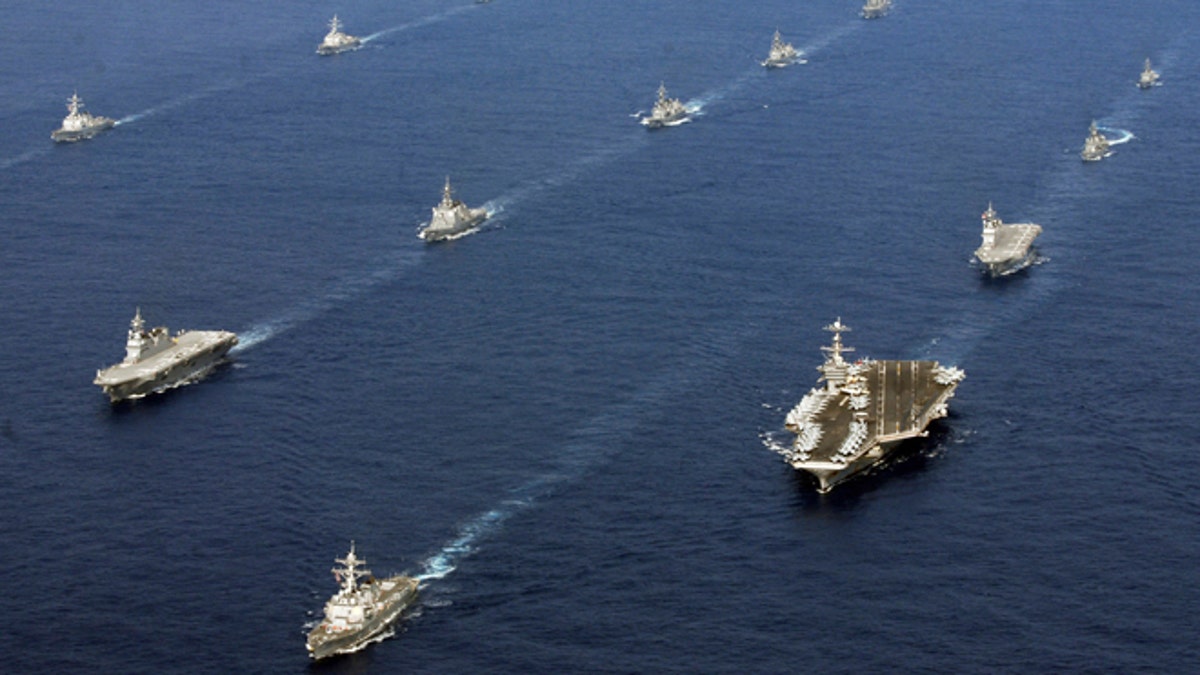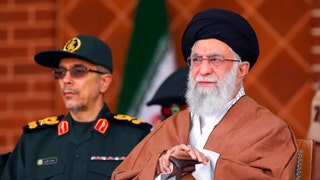
FILE -- Nov. 16, 2012: In this photo taken and released by U.S. Navy, twenty-six ships from the U.S. Navy and the Japan Maritime Self-Defense Force, including USS George Washington, bottom right, steam together in East China Sea after the conclusion of Keen Sword, a biennial naval exercise by the two countries to respond to a crisis in the Asia-Pacific region. (AP Photo/U.S. Navy, Chief Mass Communication Specialist Jennifer A. Villalovos)
The Chinese navy made history Thursday in the waters off Hawaii. For the first time ever, China’s sailors are participating in the Rim of the Pacific (RIMPAC) exercise, the world’s largest naval drill. Beijing is sending two missile warships, two support vessels, and two helicopters “deep into the tiger’s den,” as Chinese state media termed it.
RIMPAC, which includes vessels from 23 nations this year, is run by the U.S. Navy for allies and friends. China, which is configuring its forces to fight America and labels us an adversary, is neither.
[pullquote]
The Chinese navy even looks like it is spoiling for a fight. In December, in international waters in the South China Sea, one of China’s vessels created another serious incident by cutting 50 or so yards directly in front of the Cowpens, an American cruiser, forcing it to a dead stop. Beijing does not recognize the concept of a global commons and has been trying to close off Asian waters to the U.S.
Despite everything, the U.S. Navy, which has been defending freedom of navigation for more than two centuries, is still including China in RIMPAC. American admirals evidently believe that, if they try hard enough, their Chinese counterparts will have to reciprocate.
Actually, they might not. China’s admirals are especially arrogant and their goals are diametrically opposed to ours, so it’s unlikely they will cooperate, at least in the manner we hope they will. Yet the U.S. Navy’s desire to work with all maritime powers—what drives it to find partnership with a belligerent China—is, on balance, an advantage, adding to American security.
When the Chinese go to RIMPAC, they will see the true strength of the U.S. Navy. It can be intimidating on the high seas, but it is no more so than when it is acting with partners. The joint task forces it routinely leads send messages that no one nation, no matter how powerful, on its own can convey.
Rear Admiral Michael Manazir made this point when he told me how in May of last year he stared down Iranian craft that wanted to interfere with the ships he commanded in international water in the Persian Gulf. Yes, his vessels must have looked impressive to the Iranians, but what was even more fearsome was the multinational task force of which they were a part.
Manazir’s ships were but a few of the 35 vessels participating in the International Mine Countermeasures Exercise, a freedom of navigation drill that last year included 6,500 sailors and representatives from 41 nations. There is nothing so frightening for the seamen of a rogue state than to see ships from a unified coalition on the high seas backed by history’s mightiest maritime force.
Manazir no longer sits high above a carrier deck in the Middle East fending off bandits in shallow waters. He occupies a chair in the Pentagon as the Navy’s director of Air Warfare. There he thinks about integrating vertical takeoff planes on surface combatants and getting the Gerald R. Ford, the first of its class of carriers, ready to join the fleet in two years.
The most important projects that cross his desk are the next generation of weapons being developed with other nations, most notably the F-35 Lighting II, a 5th-Generation fighter that will one day rule the skies over international water. Britain’s Royal Navy is a development partner, and the fighter will be sold to various treaty allies and friends that have contributed to the program.
As a result of the joint efforts, the F-35B, the vertical takeoff version, and the F-35C, the carrier variant, will soon be deployed on our ships and those of our friends. The sharing of the plane by navies around the world will, of course, enhance interoperability, giving U.S. admirals like Manazir better ability to meet maritime threats.
The Navy’s ties with allies and friends run deep. Boeing sold variants of America’s newest eye-in-the-sky aircraft, the P-8, to both Australia, a long-time treaty ally, and India, a new friend, and the Navy has worked with both on the tactical and operational level with regard to the new plane. The cooperation paves the way for future combined operations in the increasingly troubled Indian Ocean and surrounding waters. And as a result of earlier joint efforts, the Navy’s Aegis Combat System is deployed abroad Japanese, South Koreans, Spanish, and Norwegian ships and will be on Australia’s new Hobart-class destroyers. Furthermore, the Navy is co-developing its SM-3 missile with Japan.
In the tense settings of the future, the partnerships with allied navies will be force multipliers, taking the strain off America’s shrinking defense budgets. “We’re an 11-carrier Navy in a 15-carrier world,” said Rear Admiral Thomas Moore, program executive officer for carriers, in October 2012. “The demand signal is not likely to go down any time soon.”
The “demand signal” has gone way up since then. Among other things, the Russians are more active in the Pacific now as are the Chinese. Beijing’s challenge to peace and stability has troubled neighbors in both the South China and East China Seas, where China maintains expansive territorial claims. Yet the Navy is only at ten carriers at the moment. This is the perfect time to have friends with F-35s.
And it is also the perfect time to show the Chinese, in the waters off Hawaii, what makes America so strong. If there is any reason to invite China to participate in RIMPAC, it is to make clear to Beijing that it faces not just America but its many partners as well.








































